Analysis and Critique of Big Data Analytics Journal Articles
VerifiedAdded on 2023/06/08
|6
|1766
|373
Report
AI Summary
This report presents a critical literature review of two journal articles focusing on big data analytics. The first article, by Muller et al. (2016), examines the challenges, promises, and guidelines for utilizing big data analytics in information systems research. It highlights challenges such as the absence of automation in statistical reasoning and discusses promises like improved predictive accuracy. The second article, by Sun, Pambel and Wang (2015), explores the incorporation of big data analytics into enterprise information systems, discussing the interrelation between the two and providing a model (BABES) for integration. The review critically analyzes the contribution of each article to the understanding of big data analytics, addressing the extent to which they increase knowledge on the subject. Both articles provide valuable insights, although the second article could have addressed some of the key problems related to big data analytics. Overall, the review concludes that both journals contribute significantly to the understanding of big data analytics and its application in enterprise information systems.
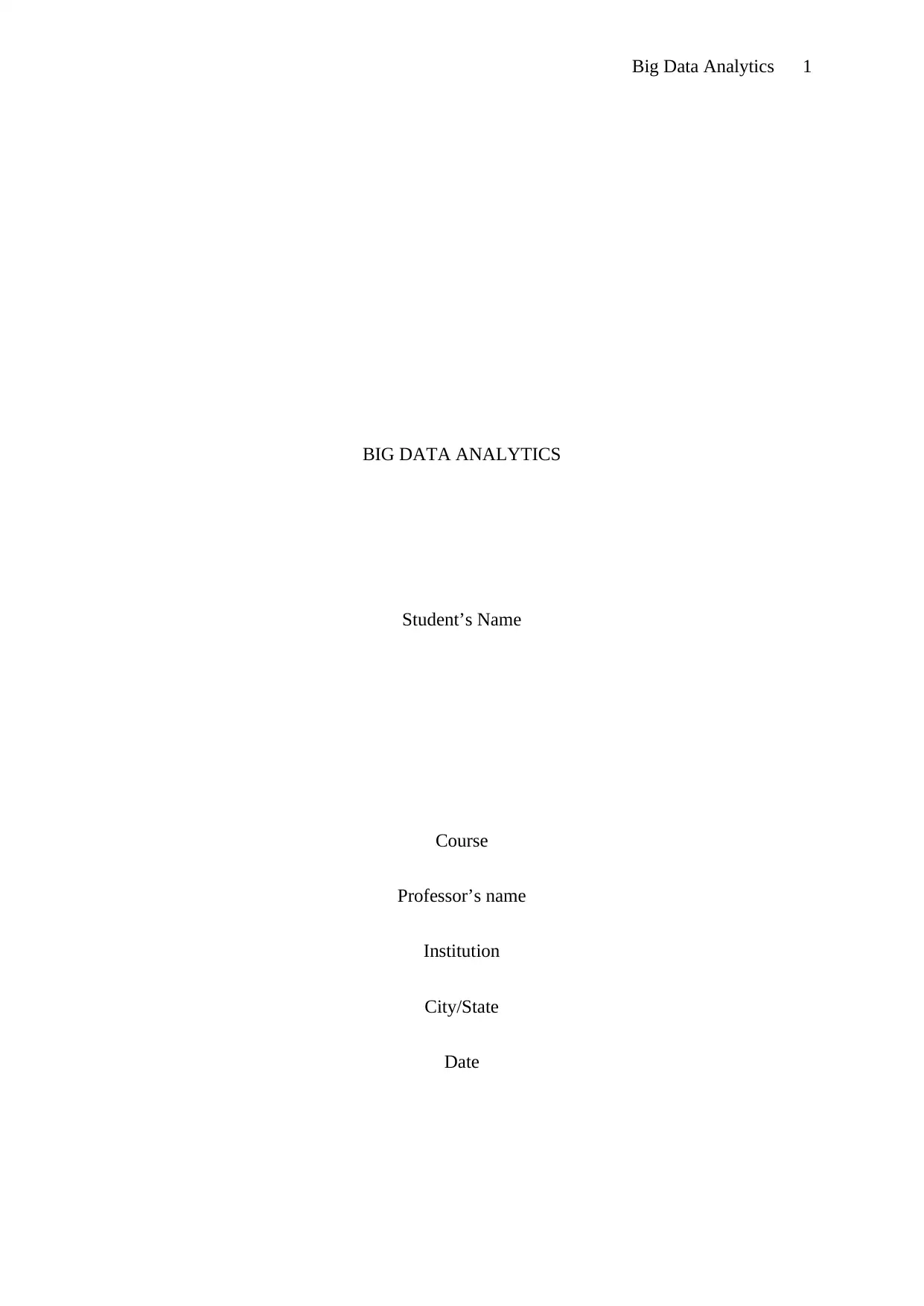
Big Data Analytics 1
BIG DATA ANALYTICS
Student’s Name
Course
Professor’s name
Institution
City/State
Date
BIG DATA ANALYTICS
Student’s Name
Course
Professor’s name
Institution
City/State
Date
Paraphrase This Document
Need a fresh take? Get an instant paraphrase of this document with our AI Paraphraser
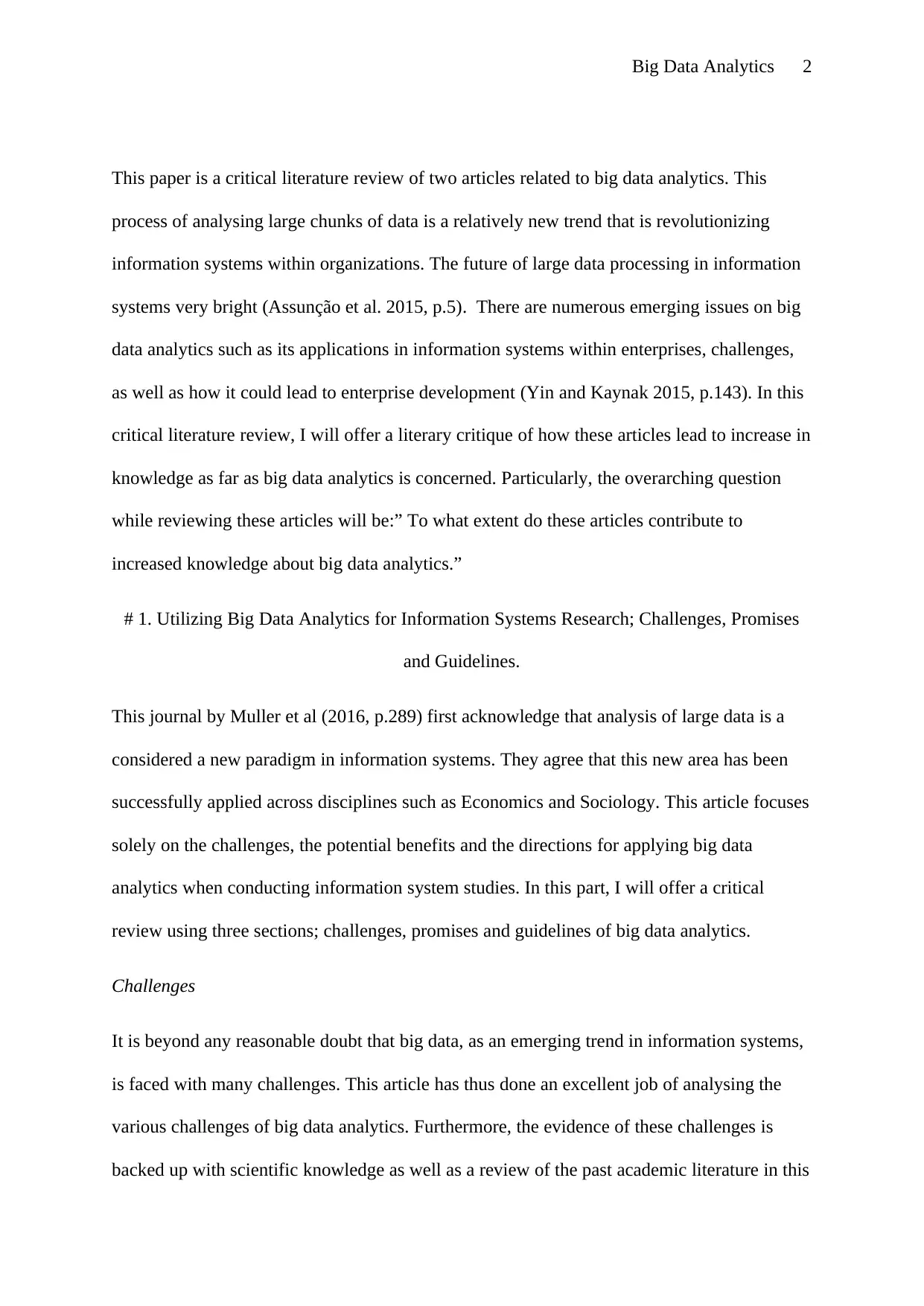
Big Data Analytics 2
This paper is a critical literature review of two articles related to big data analytics. This
process of analysing large chunks of data is a relatively new trend that is revolutionizing
information systems within organizations. The future of large data processing in information
systems very bright (Assunção et al. 2015, p.5). There are numerous emerging issues on big
data analytics such as its applications in information systems within enterprises, challenges,
as well as how it could lead to enterprise development (Yin and Kaynak 2015, p.143). In this
critical literature review, I will offer a literary critique of how these articles lead to increase in
knowledge as far as big data analytics is concerned. Particularly, the overarching question
while reviewing these articles will be:” To what extent do these articles contribute to
increased knowledge about big data analytics.”
# 1. Utilizing Big Data Analytics for Information Systems Research; Challenges, Promises
and Guidelines.
This journal by Muller et al (2016, p.289) first acknowledge that analysis of large data is a
considered a new paradigm in information systems. They agree that this new area has been
successfully applied across disciplines such as Economics and Sociology. This article focuses
solely on the challenges, the potential benefits and the directions for applying big data
analytics when conducting information system studies. In this part, I will offer a critical
review using three sections; challenges, promises and guidelines of big data analytics.
Challenges
It is beyond any reasonable doubt that big data, as an emerging trend in information systems,
is faced with many challenges. This article has thus done an excellent job of analysing the
various challenges of big data analytics. Furthermore, the evidence of these challenges is
backed up with scientific knowledge as well as a review of the past academic literature in this
This paper is a critical literature review of two articles related to big data analytics. This
process of analysing large chunks of data is a relatively new trend that is revolutionizing
information systems within organizations. The future of large data processing in information
systems very bright (Assunção et al. 2015, p.5). There are numerous emerging issues on big
data analytics such as its applications in information systems within enterprises, challenges,
as well as how it could lead to enterprise development (Yin and Kaynak 2015, p.143). In this
critical literature review, I will offer a literary critique of how these articles lead to increase in
knowledge as far as big data analytics is concerned. Particularly, the overarching question
while reviewing these articles will be:” To what extent do these articles contribute to
increased knowledge about big data analytics.”
# 1. Utilizing Big Data Analytics for Information Systems Research; Challenges, Promises
and Guidelines.
This journal by Muller et al (2016, p.289) first acknowledge that analysis of large data is a
considered a new paradigm in information systems. They agree that this new area has been
successfully applied across disciplines such as Economics and Sociology. This article focuses
solely on the challenges, the potential benefits and the directions for applying big data
analytics when conducting information system studies. In this part, I will offer a critical
review using three sections; challenges, promises and guidelines of big data analytics.
Challenges
It is beyond any reasonable doubt that big data, as an emerging trend in information systems,
is faced with many challenges. This article has thus done an excellent job of analysing the
various challenges of big data analytics. Furthermore, the evidence of these challenges is
backed up with scientific knowledge as well as a review of the past academic literature in this
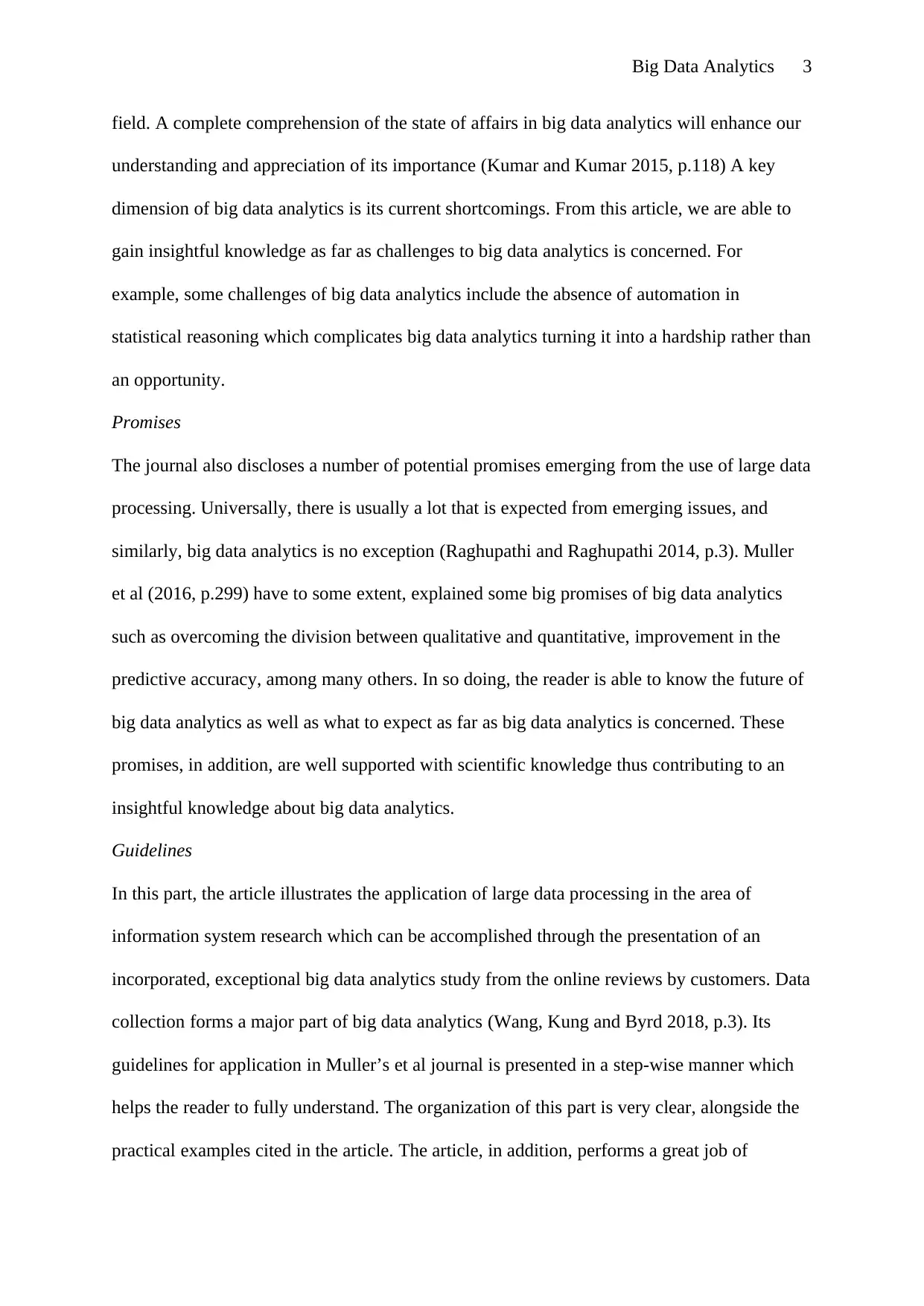
Big Data Analytics 3
field. A complete comprehension of the state of affairs in big data analytics will enhance our
understanding and appreciation of its importance (Kumar and Kumar 2015, p.118) A key
dimension of big data analytics is its current shortcomings. From this article, we are able to
gain insightful knowledge as far as challenges to big data analytics is concerned. For
example, some challenges of big data analytics include the absence of automation in
statistical reasoning which complicates big data analytics turning it into a hardship rather than
an opportunity.
Promises
The journal also discloses a number of potential promises emerging from the use of large data
processing. Universally, there is usually a lot that is expected from emerging issues, and
similarly, big data analytics is no exception (Raghupathi and Raghupathi 2014, p.3). Muller
et al (2016, p.299) have to some extent, explained some big promises of big data analytics
such as overcoming the division between qualitative and quantitative, improvement in the
predictive accuracy, among many others. In so doing, the reader is able to know the future of
big data analytics as well as what to expect as far as big data analytics is concerned. These
promises, in addition, are well supported with scientific knowledge thus contributing to an
insightful knowledge about big data analytics.
Guidelines
In this part, the article illustrates the application of large data processing in the area of
information system research which can be accomplished through the presentation of an
incorporated, exceptional big data analytics study from the online reviews by customers. Data
collection forms a major part of big data analytics (Wang, Kung and Byrd 2018, p.3). Its
guidelines for application in Muller’s et al journal is presented in a step-wise manner which
helps the reader to fully understand. The organization of this part is very clear, alongside the
practical examples cited in the article. The article, in addition, performs a great job of
field. A complete comprehension of the state of affairs in big data analytics will enhance our
understanding and appreciation of its importance (Kumar and Kumar 2015, p.118) A key
dimension of big data analytics is its current shortcomings. From this article, we are able to
gain insightful knowledge as far as challenges to big data analytics is concerned. For
example, some challenges of big data analytics include the absence of automation in
statistical reasoning which complicates big data analytics turning it into a hardship rather than
an opportunity.
Promises
The journal also discloses a number of potential promises emerging from the use of large data
processing. Universally, there is usually a lot that is expected from emerging issues, and
similarly, big data analytics is no exception (Raghupathi and Raghupathi 2014, p.3). Muller
et al (2016, p.299) have to some extent, explained some big promises of big data analytics
such as overcoming the division between qualitative and quantitative, improvement in the
predictive accuracy, among many others. In so doing, the reader is able to know the future of
big data analytics as well as what to expect as far as big data analytics is concerned. These
promises, in addition, are well supported with scientific knowledge thus contributing to an
insightful knowledge about big data analytics.
Guidelines
In this part, the article illustrates the application of large data processing in the area of
information system research which can be accomplished through the presentation of an
incorporated, exceptional big data analytics study from the online reviews by customers. Data
collection forms a major part of big data analytics (Wang, Kung and Byrd 2018, p.3). Its
guidelines for application in Muller’s et al journal is presented in a step-wise manner which
helps the reader to fully understand. The organization of this part is very clear, alongside the
practical examples cited in the article. The article, in addition, performs a great job of
⊘ This is a preview!⊘
Do you want full access?
Subscribe today to unlock all pages.

Trusted by 1+ million students worldwide
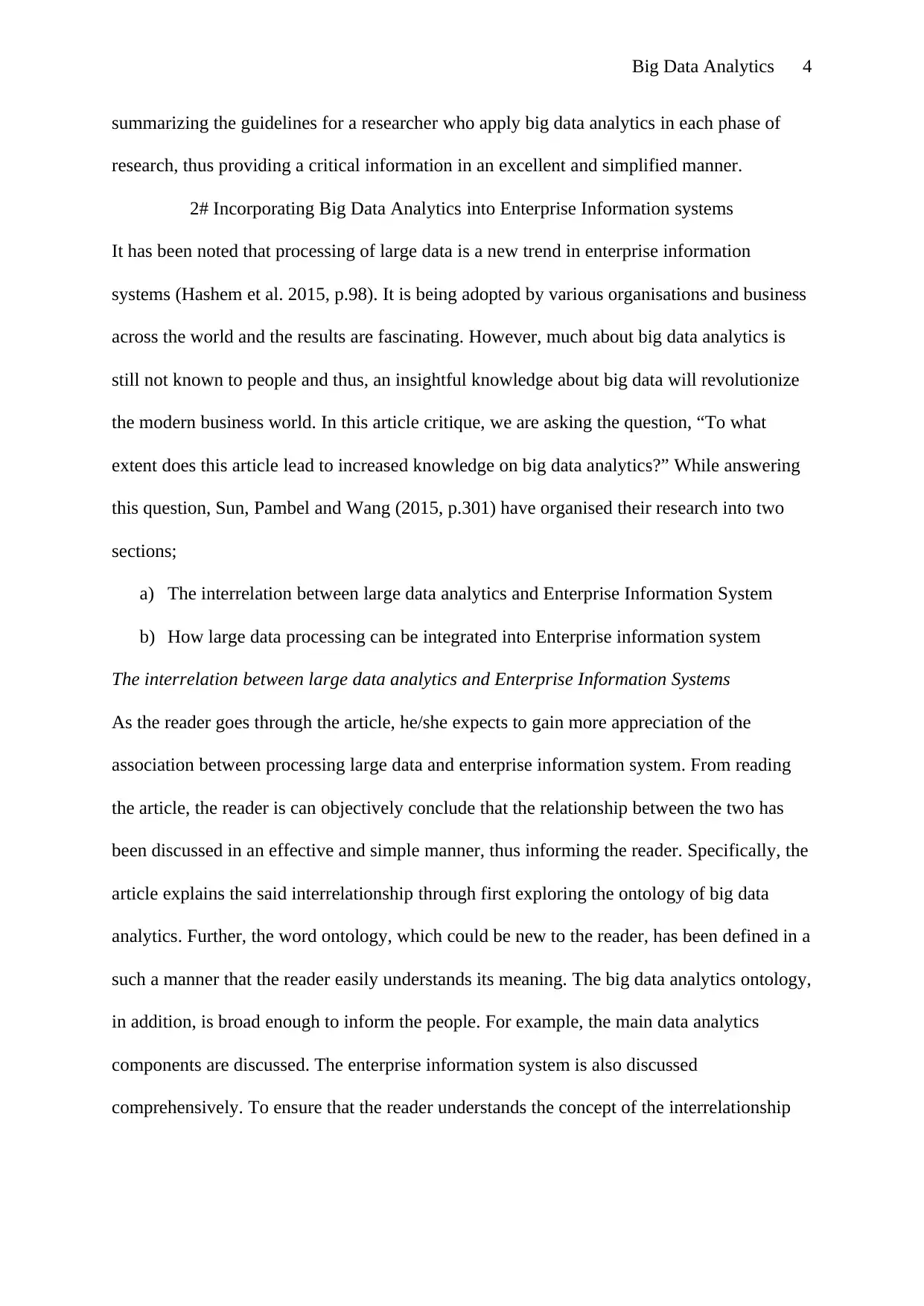
Big Data Analytics 4
summarizing the guidelines for a researcher who apply big data analytics in each phase of
research, thus providing a critical information in an excellent and simplified manner.
2# Incorporating Big Data Analytics into Enterprise Information systems
It has been noted that processing of large data is a new trend in enterprise information
systems (Hashem et al. 2015, p.98). It is being adopted by various organisations and business
across the world and the results are fascinating. However, much about big data analytics is
still not known to people and thus, an insightful knowledge about big data will revolutionize
the modern business world. In this article critique, we are asking the question, “To what
extent does this article lead to increased knowledge on big data analytics?” While answering
this question, Sun, Pambel and Wang (2015, p.301) have organised their research into two
sections;
a) The interrelation between large data analytics and Enterprise Information System
b) How large data processing can be integrated into Enterprise information system
The interrelation between large data analytics and Enterprise Information Systems
As the reader goes through the article, he/she expects to gain more appreciation of the
association between processing large data and enterprise information system. From reading
the article, the reader is can objectively conclude that the relationship between the two has
been discussed in an effective and simple manner, thus informing the reader. Specifically, the
article explains the said interrelationship through first exploring the ontology of big data
analytics. Further, the word ontology, which could be new to the reader, has been defined in a
such a manner that the reader easily understands its meaning. The big data analytics ontology,
in addition, is broad enough to inform the people. For example, the main data analytics
components are discussed. The enterprise information system is also discussed
comprehensively. To ensure that the reader understands the concept of the interrelationship
summarizing the guidelines for a researcher who apply big data analytics in each phase of
research, thus providing a critical information in an excellent and simplified manner.
2# Incorporating Big Data Analytics into Enterprise Information systems
It has been noted that processing of large data is a new trend in enterprise information
systems (Hashem et al. 2015, p.98). It is being adopted by various organisations and business
across the world and the results are fascinating. However, much about big data analytics is
still not known to people and thus, an insightful knowledge about big data will revolutionize
the modern business world. In this article critique, we are asking the question, “To what
extent does this article lead to increased knowledge on big data analytics?” While answering
this question, Sun, Pambel and Wang (2015, p.301) have organised their research into two
sections;
a) The interrelation between large data analytics and Enterprise Information System
b) How large data processing can be integrated into Enterprise information system
The interrelation between large data analytics and Enterprise Information Systems
As the reader goes through the article, he/she expects to gain more appreciation of the
association between processing large data and enterprise information system. From reading
the article, the reader is can objectively conclude that the relationship between the two has
been discussed in an effective and simple manner, thus informing the reader. Specifically, the
article explains the said interrelationship through first exploring the ontology of big data
analytics. Further, the word ontology, which could be new to the reader, has been defined in a
such a manner that the reader easily understands its meaning. The big data analytics ontology,
in addition, is broad enough to inform the people. For example, the main data analytics
components are discussed. The enterprise information system is also discussed
comprehensively. To ensure that the reader understands the concept of the interrelationship
Paraphrase This Document
Need a fresh take? Get an instant paraphrase of this document with our AI Paraphraser
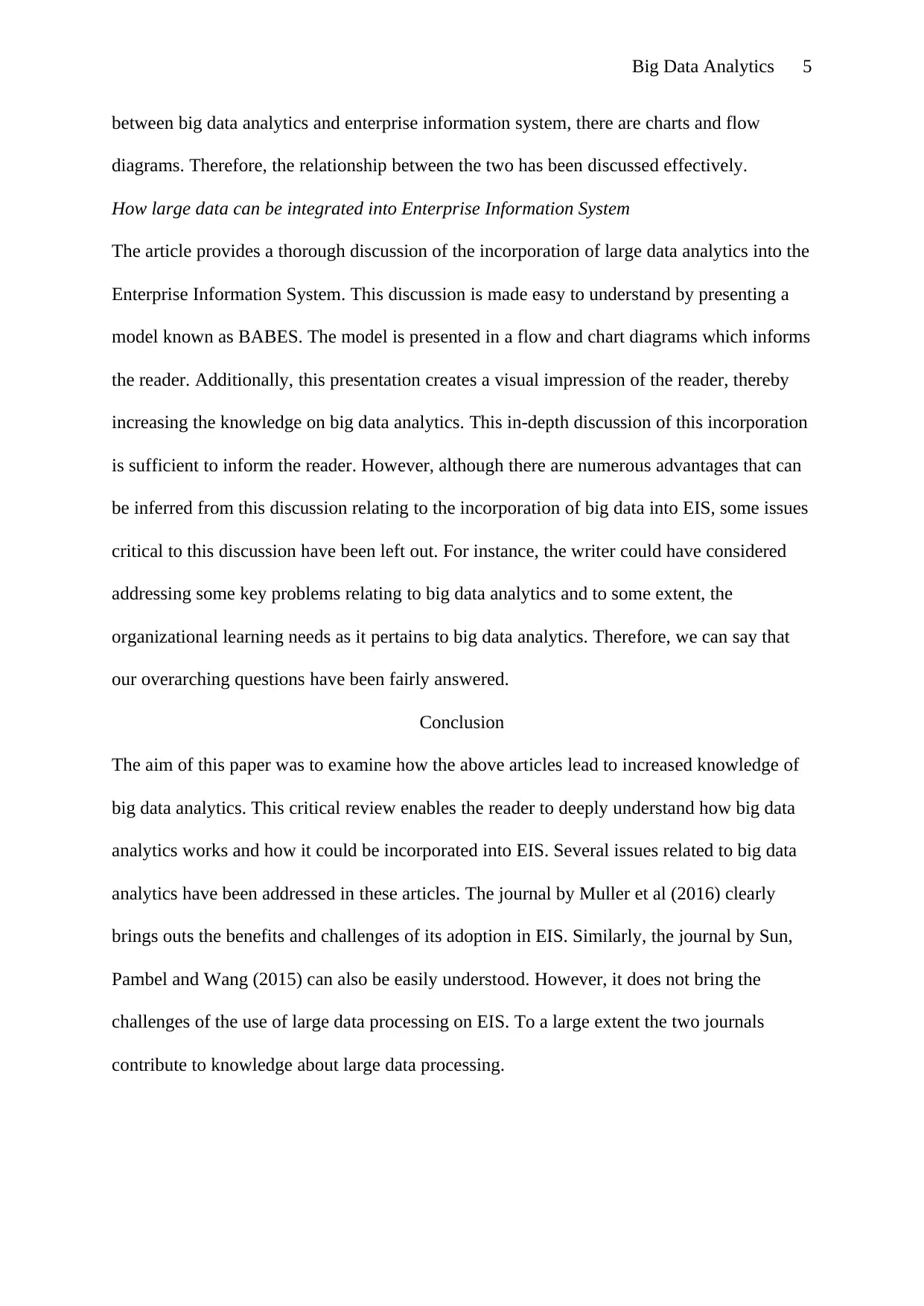
Big Data Analytics 5
between big data analytics and enterprise information system, there are charts and flow
diagrams. Therefore, the relationship between the two has been discussed effectively.
How large data can be integrated into Enterprise Information System
The article provides a thorough discussion of the incorporation of large data analytics into the
Enterprise Information System. This discussion is made easy to understand by presenting a
model known as BABES. The model is presented in a flow and chart diagrams which informs
the reader. Additionally, this presentation creates a visual impression of the reader, thereby
increasing the knowledge on big data analytics. This in-depth discussion of this incorporation
is sufficient to inform the reader. However, although there are numerous advantages that can
be inferred from this discussion relating to the incorporation of big data into EIS, some issues
critical to this discussion have been left out. For instance, the writer could have considered
addressing some key problems relating to big data analytics and to some extent, the
organizational learning needs as it pertains to big data analytics. Therefore, we can say that
our overarching questions have been fairly answered.
Conclusion
The aim of this paper was to examine how the above articles lead to increased knowledge of
big data analytics. This critical review enables the reader to deeply understand how big data
analytics works and how it could be incorporated into EIS. Several issues related to big data
analytics have been addressed in these articles. The journal by Muller et al (2016) clearly
brings outs the benefits and challenges of its adoption in EIS. Similarly, the journal by Sun,
Pambel and Wang (2015) can also be easily understood. However, it does not bring the
challenges of the use of large data processing on EIS. To a large extent the two journals
contribute to knowledge about large data processing.
between big data analytics and enterprise information system, there are charts and flow
diagrams. Therefore, the relationship between the two has been discussed effectively.
How large data can be integrated into Enterprise Information System
The article provides a thorough discussion of the incorporation of large data analytics into the
Enterprise Information System. This discussion is made easy to understand by presenting a
model known as BABES. The model is presented in a flow and chart diagrams which informs
the reader. Additionally, this presentation creates a visual impression of the reader, thereby
increasing the knowledge on big data analytics. This in-depth discussion of this incorporation
is sufficient to inform the reader. However, although there are numerous advantages that can
be inferred from this discussion relating to the incorporation of big data into EIS, some issues
critical to this discussion have been left out. For instance, the writer could have considered
addressing some key problems relating to big data analytics and to some extent, the
organizational learning needs as it pertains to big data analytics. Therefore, we can say that
our overarching questions have been fairly answered.
Conclusion
The aim of this paper was to examine how the above articles lead to increased knowledge of
big data analytics. This critical review enables the reader to deeply understand how big data
analytics works and how it could be incorporated into EIS. Several issues related to big data
analytics have been addressed in these articles. The journal by Muller et al (2016) clearly
brings outs the benefits and challenges of its adoption in EIS. Similarly, the journal by Sun,
Pambel and Wang (2015) can also be easily understood. However, it does not bring the
challenges of the use of large data processing on EIS. To a large extent the two journals
contribute to knowledge about large data processing.
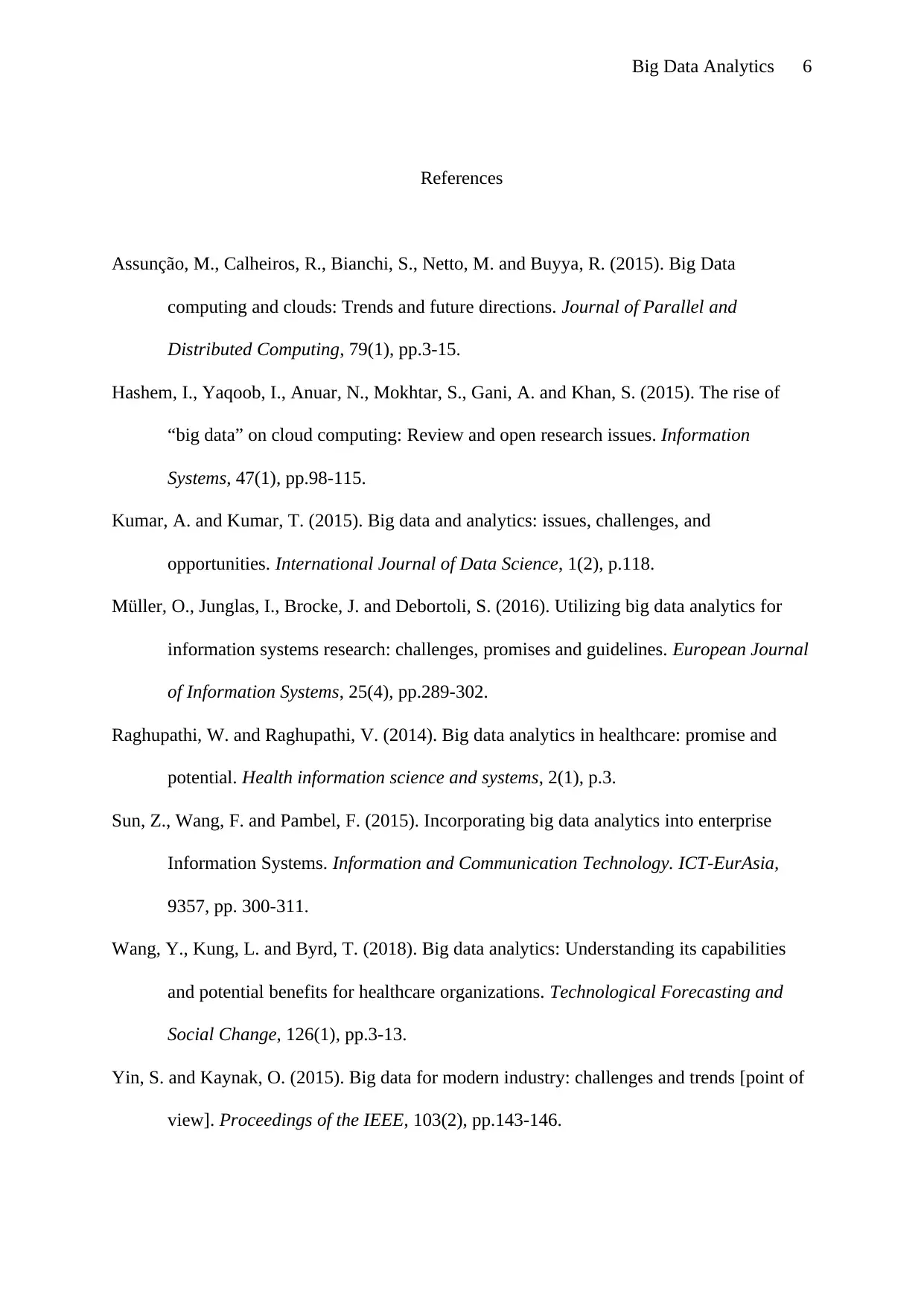
Big Data Analytics 6
References
Assunção, M., Calheiros, R., Bianchi, S., Netto, M. and Buyya, R. (2015). Big Data
computing and clouds: Trends and future directions. Journal of Parallel and
Distributed Computing, 79(1), pp.3-15.
Hashem, I., Yaqoob, I., Anuar, N., Mokhtar, S., Gani, A. and Khan, S. (2015). The rise of
“big data” on cloud computing: Review and open research issues. Information
Systems, 47(1), pp.98-115.
Kumar, A. and Kumar, T. (2015). Big data and analytics: issues, challenges, and
opportunities. International Journal of Data Science, 1(2), p.118.
Müller, O., Junglas, I., Brocke, J. and Debortoli, S. (2016). Utilizing big data analytics for
information systems research: challenges, promises and guidelines. European Journal
of Information Systems, 25(4), pp.289-302.
Raghupathi, W. and Raghupathi, V. (2014). Big data analytics in healthcare: promise and
potential. Health information science and systems, 2(1), p.3.
Sun, Z., Wang, F. and Pambel, F. (2015). Incorporating big data analytics into enterprise
Information Systems. Information and Communication Technology. ICT-EurAsia,
9357, pp. 300-311.
Wang, Y., Kung, L. and Byrd, T. (2018). Big data analytics: Understanding its capabilities
and potential benefits for healthcare organizations. Technological Forecasting and
Social Change, 126(1), pp.3-13.
Yin, S. and Kaynak, O. (2015). Big data for modern industry: challenges and trends [point of
view]. Proceedings of the IEEE, 103(2), pp.143-146.
References
Assunção, M., Calheiros, R., Bianchi, S., Netto, M. and Buyya, R. (2015). Big Data
computing and clouds: Trends and future directions. Journal of Parallel and
Distributed Computing, 79(1), pp.3-15.
Hashem, I., Yaqoob, I., Anuar, N., Mokhtar, S., Gani, A. and Khan, S. (2015). The rise of
“big data” on cloud computing: Review and open research issues. Information
Systems, 47(1), pp.98-115.
Kumar, A. and Kumar, T. (2015). Big data and analytics: issues, challenges, and
opportunities. International Journal of Data Science, 1(2), p.118.
Müller, O., Junglas, I., Brocke, J. and Debortoli, S. (2016). Utilizing big data analytics for
information systems research: challenges, promises and guidelines. European Journal
of Information Systems, 25(4), pp.289-302.
Raghupathi, W. and Raghupathi, V. (2014). Big data analytics in healthcare: promise and
potential. Health information science and systems, 2(1), p.3.
Sun, Z., Wang, F. and Pambel, F. (2015). Incorporating big data analytics into enterprise
Information Systems. Information and Communication Technology. ICT-EurAsia,
9357, pp. 300-311.
Wang, Y., Kung, L. and Byrd, T. (2018). Big data analytics: Understanding its capabilities
and potential benefits for healthcare organizations. Technological Forecasting and
Social Change, 126(1), pp.3-13.
Yin, S. and Kaynak, O. (2015). Big data for modern industry: challenges and trends [point of
view]. Proceedings of the IEEE, 103(2), pp.143-146.
⊘ This is a preview!⊘
Do you want full access?
Subscribe today to unlock all pages.

Trusted by 1+ million students worldwide
1 out of 6
Related Documents
Your All-in-One AI-Powered Toolkit for Academic Success.
+13062052269
info@desklib.com
Available 24*7 on WhatsApp / Email
![[object Object]](/_next/static/media/star-bottom.7253800d.svg)
Unlock your academic potential
Copyright © 2020–2025 A2Z Services. All Rights Reserved. Developed and managed by ZUCOL.





